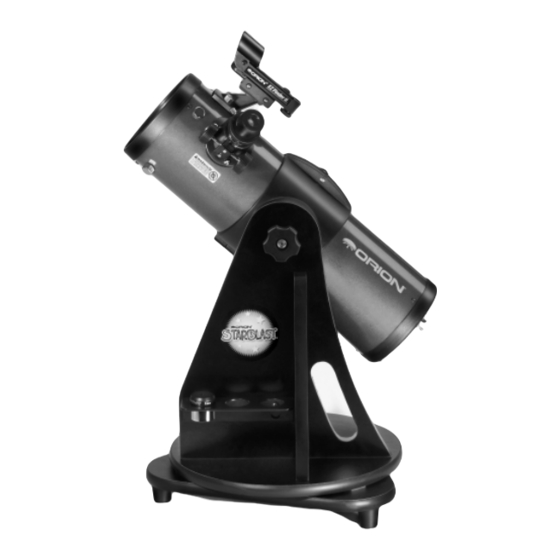
Orion StarBlast 4.5" Instruction Manual
Hide thumbs
Also See for StarBlast 4.5":
- Instruction manual (14 pages) ,
- Instruction manual (16 pages) ,
- Instruction manual (16 pages)
Advertisement
Quick Links
The Missoula Public Library
406-721-2665
And the Library Telescope Program of
The Western Montana
Astronomical Association
Orion StarBlast 4.5" Telescope
INSTRUCTION MANUAL
WARNING: Never look directly at the Sun through your telescope or its finder scope — even for
an instant — as permanent eye damage could result. Do not point the telescope at the Sun, as
parts will melt! Children should use this telescope only with adult supervision.
1
Advertisement

Summary of Contents for Orion StarBlast 4.5"
- Page 1 And the Library Telescope Program of The Western Montana Astronomical Association Orion StarBlast 4.5" Telescope INSTRUCTION MANUAL WARNING: Never look directly at the Sun through your telescope or its finder scope — even for an instant — as permanent eye damage could result. Do not point the telescope at the Sun, as...
- Page 2 The Western Montana Astronomical Association The WMAA is an educational organization that promotes public awareness of astronomy. We hold public star parties, demonstrations, presentations, and discussions, all free of charge. Visit http://missoulasky.org for more information about club events and contact information.Our meetings are typically the 2nd Friday of every month either at the Target Range School Library or the Montana Natural History Center’s Native Garden Plant Classroom.
- Page 3 Telescope Parts 1) Eyepiece (Zoom 8 to 24 mm) 2) EZ Finder with AA battery box 3) Telescope tube 4) Focuser 5) Tube Clamp 6) Altitude Clamp 7) Mirror Assembly 8) Support 9) Handle 10) Eyepiece rack (removed)
- Page 4 Focuser Details 13) Focus wheels 14) Eyepiece securing screws (replaced with hex screws) EZ Finder Details...
- Page 5 Transporting the Telescope The telescope comes in a hard carrying case to minimize damage while transporting the telescope and bundle accompanying items along with it. It is easy to lift with one person, though two can be helpful to navigate it through doors and into cars. Grab both handles securely and ensure that the clasps on the front of the case are closed completely before lifting.
-
Page 6: Care And Maintenance
Care and Maintenance Aligning the Mirrors: Again, please don’t. If it seems that the telescope is in need of adjustment, please tell a librarian. Fog on the mirrors and eyepieces: One of the odd things that happens when star gazing is that dew forms on pretty much everything (and everyone). -
Page 7: Getting Started
Getting Started Please read the instructions and practice with the telescope inside before you take it out in the dark. The image will be much better if you let the telescope cool down to air temperature before you start observing. This is a “Push-to”... - Page 8 This is important enough to say again: WARNING: Never look directly at the Sun through your telescope or its finder scope — even for an instant - as permanent eye damage could result. This is one of the few really bad things you can do to yourself twice.
- Page 9 Many “deep-sky” objects are big, but dim. Low magnification will be better for them. Once you’ve centered an object in the eyepiece, you can switch to a higher magnification by twisting the zooms’ barrel towards the “8”. This is recommended for small and bright objects, like planets and double stars.
- Page 10 dot can be adjusted by turning the power knob. Use the dimmest possible setting that allows you to see the dot without difficulty. When the EZ Finder is properly aligned with the telescope, an object that is centered on the EZ Finder’s red dot should also appear in the center of the telescope’s eyepiece.
- Page 11 to see color in deep-sky objects, except in a few of the brightest ones. Remember that you are seeing these objects using your own eyes! Each session with your telescope will be a learning experience. Each time you work with the telescope, it will get easier to use, and stellar objects will become easier to find.
- Page 12 The Planets: They do not stay at “fixed” locations like the stars do. To find them you should refer to Sky Maps (www.skymaps.com), or to charts published monthly in Astronomy, Sky & Telescope, or other astronomy magazines and web sites. Venus, Jupiter, and Saturn are the brightest objects in the sky after the Sun and the Moon.
- Page 13 Pay particular attention to objects with a “Messier Number”, like The Orion Nebula (M-42) and the Andromeda Galaxy (M-31). First published in 1774, Charles Messier made this list to help observers identify objects that might be mistaken for comets.
- Page 14 You can also try a low-power (24 mm) scanning of the Milky Way: just cruise through the “star clouds” of our galaxy. You’ll be amazed at the rich fields of stars and objects you’ll see! When to go observing: “Seeing” and Transparency: Atmospheric conditions vary significantly from night to night. “Seeing”...
- Page 15 One more time, and with Feeling! WARNING: Never look directly at the Sun through your telescope or its finder scope — even for an instant — or permanent eye damage could result. Do not point the telescope at the Sun, as parts will melt! Children should use this telescope only with adult supervision If you go to http://cleardarksky.com/c/MissoulaMTkey.html?1, you will find the “Clear Sky Chart”...
- Page 16 The Field Guide and Planisphere The telescope is accompanied by both The National Audubon Society Field Guide to the Night Sky and a planisphere. These are both very helpful tools to use to find out what’s in the sky no matter what time of year.
















Need help?
Do you have a question about the StarBlast 4.5" and is the answer not in the manual?
Questions and answers